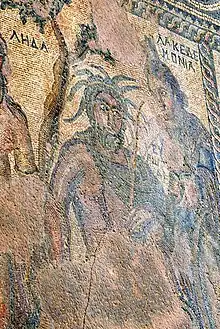Lelex
In Greek mythology, Lelex (/ˈliːlɪks/; Ancient Greek: Λέλεξ, gen. Λέλεγος) was one of the original inhabitants of Laconia which was called after him, its first king, Lelegia.
Lelex | |
|---|---|
| Spouse(s) | Cleocharia |
| Children | Myles Polycaon Pterelaus |
| Parent(s) | Helios (father) |
Family
Lelex was said to be autochthonous[1] or his father is said to be the sun-god Helios. He was married to the Naiad nymph Cleocharia and became the father of several sons, including Myles and Polycaon. Some call his wife Peridia, and his children Myles, Polyclon, Bomolochus, and Therapne.[2]
In other traditions, again, Lelex is described as a son of Spartus, and as the father of Amyclas.[3]
Through Myles, Lelex was the grandfather of Eurotas who had a daughter named Sparta.[4] This woman later marry Lacedaemon[5] who named the city of Sparta after his wife; however, the city's name would also be his own, as it was called either Lacedaemon or Sparta interchangeably.
Sources indicate that Perseus is a descendant of Lelex. Lelex’s great-granddaughter Sparta gave birth to a daughter named Eurydice who had married Acrisius, the king of Argos. Eurydice became the mother of Danaë, thus making her Perseus’ grandmother.[6]
Mythology
Lelex appears to have been conceived by ancient mythographers as the eponymous founder of the Leleges, a semi-mythical people who lived on both sides of the Aegean Sea.[7] He had a heroum at Sparta.[8]
Notes
- Pseudo-Apollodorus, Bibliotheca 3.10.3
- Scholia ad Euripides, Orestes 61.5
- Stephanus of Byzantium, Ethnica s.v. Lakedaimon
- Guide to Greece, 3.1.1-3.
- Pausanias. "Sparta, mythical history". Description of Greece, translated by WHS Jones.
- Grimal, Pierre, The Dictionary of Classical Mythology, Wiley-Blackwell, 1996, ISBN 978-0-631-20102-1. "Eurydice" (2), p. 157.
- Pausanias, Graeciae Descriptio 4.1.1
- Pausanias, Graeciae Descriptio 3.12.5
| Regnal titles | ||
|---|---|---|
| Preceded by None |
King of Sparta C. 1600 BC |
Succeeded by Myles |

